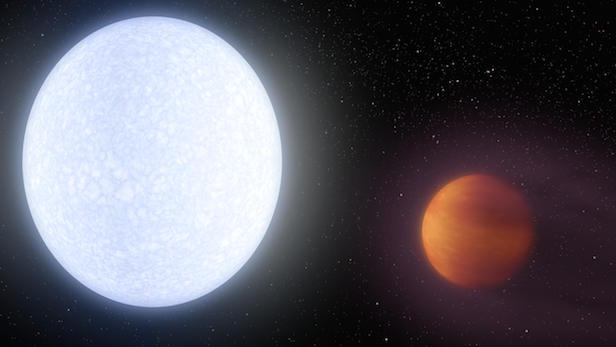Exoplanet found to be hotter than most stars
A new ‘hot Jupiter’ has been discovered and it possesses some infernal conditions

This artist’s impression of the ‘hot Jupiter’ is bombarded by intense radiation from KELT-9. Image credit: NASA/JPL-Caltech
Astronomers at Ohio State University, United States, have found a new world and they have discovered that it possesses a scorching, unpleasant environment. Its host star, an A-type main sequence star, causes this ‘hot Jupiter’ to be hotter than many stars in the universe, and gradually strips its material away.
Studying worlds beyond our Solar System is a fascinating branch of planetary science. The KELT-North telescope at the Winer Observatory, Arizona stumbled across the sizzling world in 2014, which was later named KELT-9b. The exoplanet’s star is twice the size and temperature of our Sun, and its orbit is so tight that it completes it in 1.5 Earth days.
After analysing the planet, its physical properties were deduced, showing that it is 2.8 times the size of Jupiter, but only has half the gas giant’s density. KELT-9b is also tidally-locked to its star with only one side of its surface facing it, much like our Moon to Earth. This tidal-locking of KELT-9b causes one side to be constantly bombarded with high intensity ultraviolet radiation, stripping away any atmosphere in its way, and possibly causing a tail of material as it strips the planet of its constituents. This radiation from KELT-9 is what causes the exoplanet to puff up, increasing its size whilst still possessing a low density.
The surface temperature for KELT-9b is what got you reading this however, and the side that faces its parent star is over a hellish 4300 degrees Celsius (7,800 degrees Fahrenheit), making it much hotter than the most abundant star in the universe – the red dwarf star. The side of KELT-9b that faces towards space reaches a 648 degrees Celsius (1,200 degrees Fahrenheit).
The future for KELT-9b, unlike its host star, is not very bright. KELT-9 is a relatively young star, and because of its high intensity, it will use all of its fuel and begin expanding. In the next few million years, this expansion will eventually swallow this epistellar Jovian. Nonetheless, it’s the past that interests astronomers most of all: by understanding how exoplanets like this come to exist and continue to perpetuate around hot, giant stars, we could potentially understand what it would take identify a habitable planet around such a star.
Keep up to date with the latest space news in All About Space – available every month for just £4.99. Alternatively you can subscribe here for a fraction of the price!




